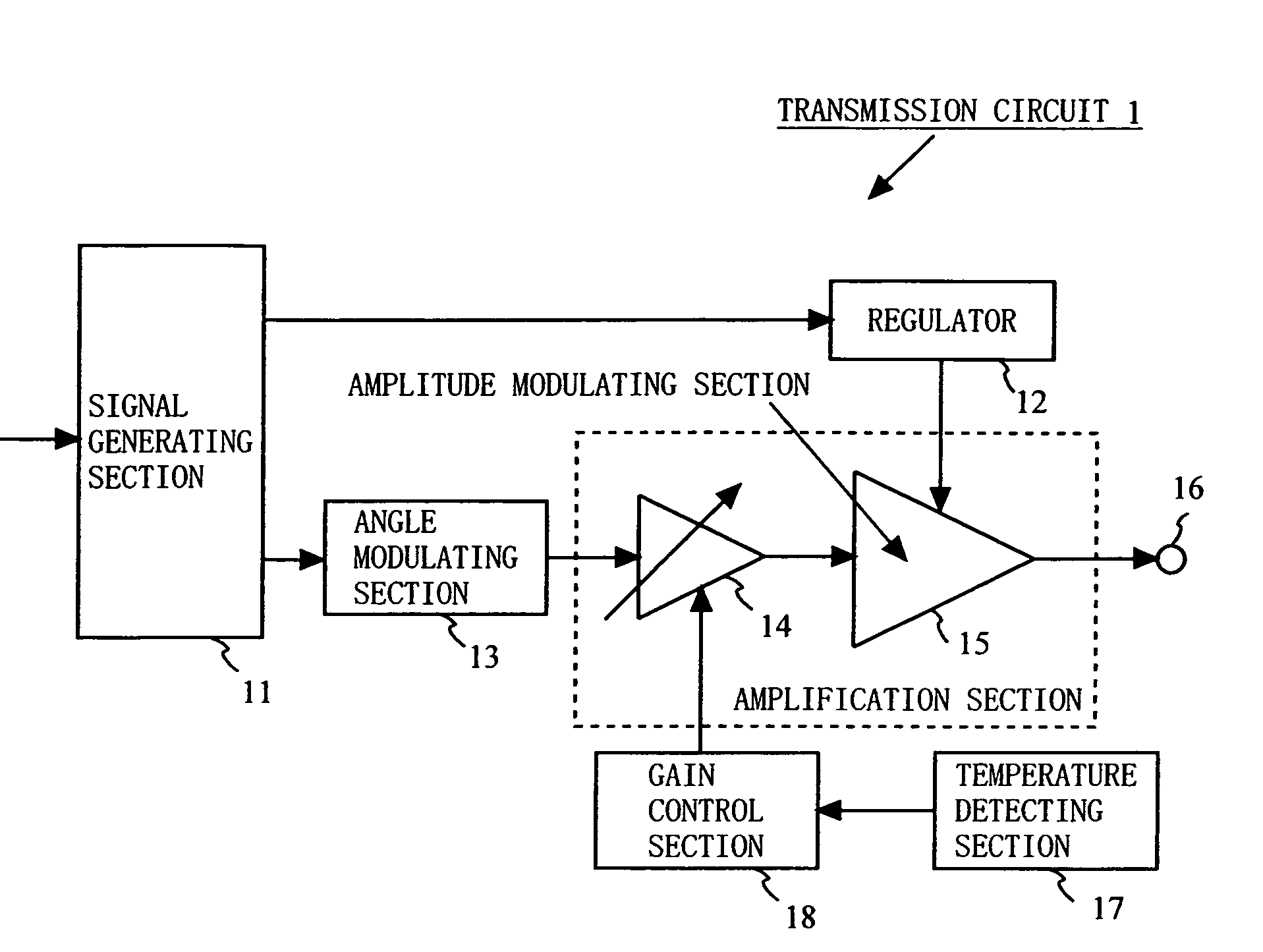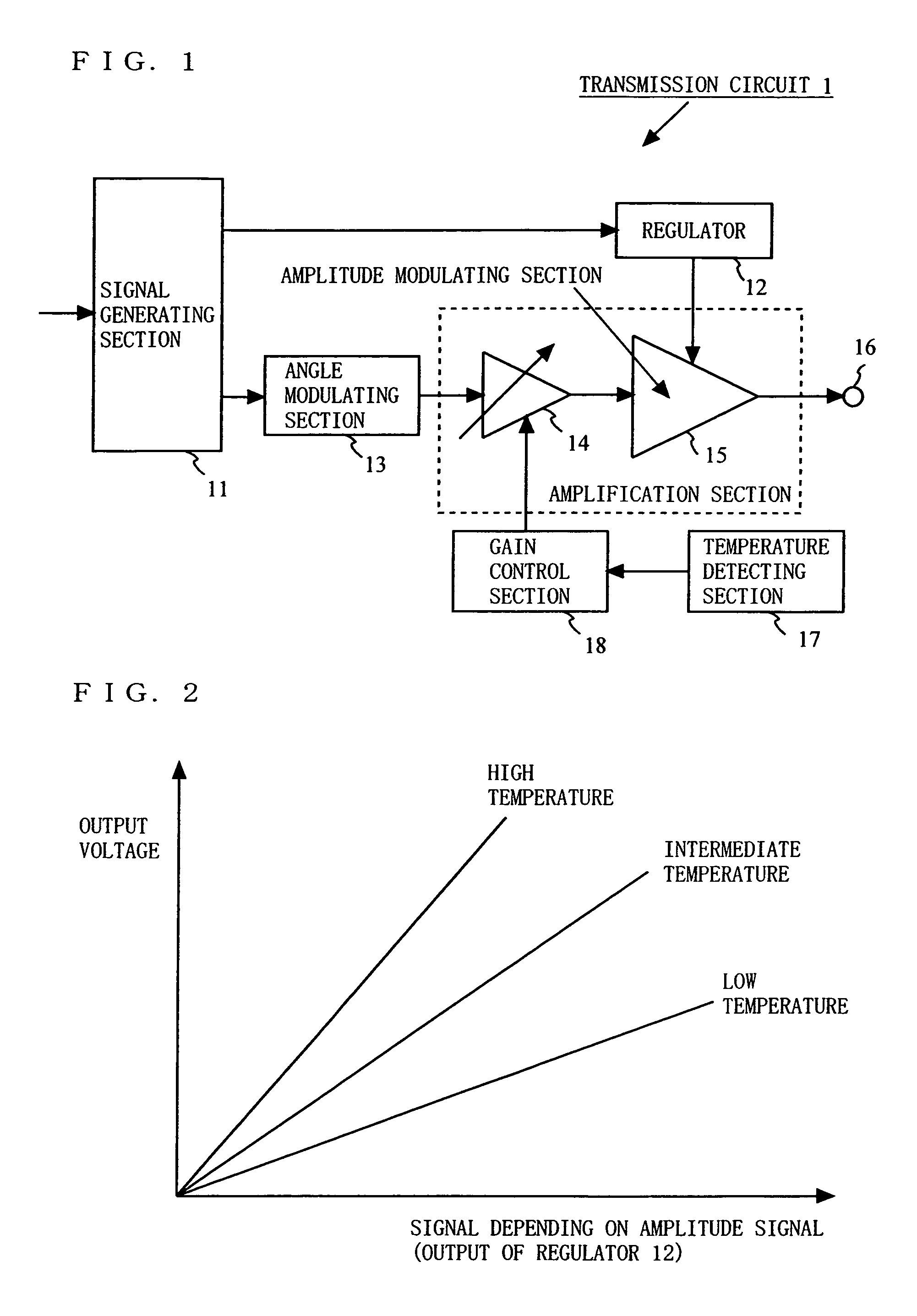Transmission circuit and communication apparatus employing the same
a transmission circuit and communication apparatus technology, applied in the field of transmission circuits, can solve the problems of large power consumption of the transmission circuit, deterioration of the linearity of the transmission signal, etc., and achieve the effects of high linearity, high efficiency of operation, and small siz
- Summary
- Abstract
- Description
- Claims
- Application Information
AI Technical Summary
Benefits of technology
Problems solved by technology
Method used
Image
Examples
first embodiment
[0073]FIG. 1 is a block diagram illustrating an exemplary configuration of a transmission circuit 1 according to a first embodiment of the present invention. In FIG. 1, the transmission circuit 1 comprises a signal generating section 11, a regulator 12, an angle modulating section 13, a variable gain amplifier 14, an amplitude modulating section 15, an output terminal 16, a temperature detecting section 17, and a gain control section 18. Note that the variable gain amplifier 14 and the amplitude modulating section 15 may be simply described as an amplification section.
[0074]The signal generating section 11 generates an amplitude signal and a phase signal, depending on input data. For example, the signal generating section 11 generates an amplitude signal and a phase signal based on an amplitude component and a phase component obtained by subjecting the input data to signal processing. Note that the signal generating section 11 may be referred to as a polar-coordinate signal generati...
second embodiment
[0095]FIG. 11 is a block diagram illustrating an exemplary configuration of a transmission circuit 2 according to a second embodiment of the present invention. In FIG. 11, the transmission circuit 2 comprises a signal generating section 11, a regulator 12, an angle modulating section 13, an amplitude modulating section 15, an output terminal 16, a temperature detecting section 17, and a gain control section 18a. Note that the amplitude modulating section 15 may be simply referred to as an amplification section.
[0096]The signal generating section 11 generates an amplitude signal and a phase signal based on input data. The amplitude signal generated in the signal generating section 11 is input to the regulator 12. The regulator 12 outputs a signal depending on a magnitude of the input amplitude signal. Typically, the regulator 12 outputs a signal having a magnitude which is proportional to the magnitude of the amplitude signal. The signal output from the regulator 12 is input to the a...
third embodiment
[0105]FIG. 15 is a block diagram illustrating an exemplary configuration of a transmission circuit 3 according to a third embodiment of the present invention. In FIG. 15, the transmission circuit 3 is the same as the transmission circuit 1 of the first embodiment, except that the transmission circuit 3 further comprises an offset control section 19 and an offset compensating section 20. The offset control section 19 outputs an AM offset value which is to be added to an amplitude signal, based on the temperature information output from the temperature detecting section 17. The offset compensating section 20 adds the AM offset value output from the offset control section 19 to the amplitude signal.
[0106]FIG. 16 is a diagram illustrating an example of the characteristics of the amplitude modulating section 15. When the amplitude modulating section 15 includes, for example, a Heterojunction Bipolar Transistor (HBT), the amplitude modulating section 15 exhibits characteristics as illustr...
PUM
 Login to View More
Login to View More Abstract
Description
Claims
Application Information
 Login to View More
Login to View More - R&D
- Intellectual Property
- Life Sciences
- Materials
- Tech Scout
- Unparalleled Data Quality
- Higher Quality Content
- 60% Fewer Hallucinations
Browse by: Latest US Patents, China's latest patents, Technical Efficacy Thesaurus, Application Domain, Technology Topic, Popular Technical Reports.
© 2025 PatSnap. All rights reserved.Legal|Privacy policy|Modern Slavery Act Transparency Statement|Sitemap|About US| Contact US: help@patsnap.com



